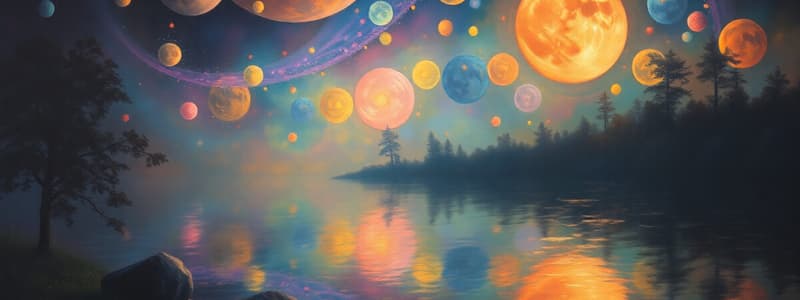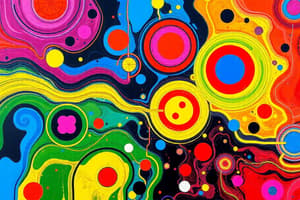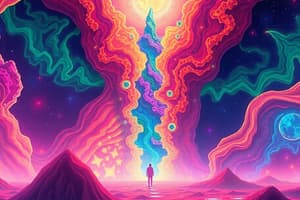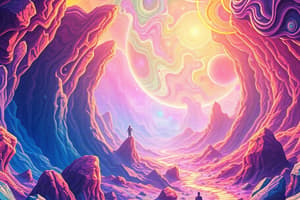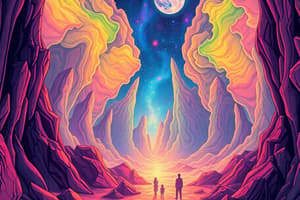Podcast
Questions and Answers
What characterizes anxiety disorders as opposed to adaptive anxiety?
What characterizes anxiety disorders as opposed to adaptive anxiety?
- Anxiety disorders arise from a lack of fear.
- Anxiety disorders involve maladaptive responses that disrupt everyday life. (correct)
- Anxiety disorders are characterized by a complete absence of worry.
- Anxiety disorders primarily focus on post-traumatic stress.
Which of the following best describes generalized anxiety disorder (GAD)?
Which of the following best describes generalized anxiety disorder (GAD)?
- It only arises in response to traumatic events.
- It leads to compulsive behaviors to alleviate anxiety.
- It is characterized by chronic, excessive worry about various events. (correct)
- It involves intense fear of specific objects or situations.
Which brain structure is primarily involved in the physiological response to fear and anxiety?
Which brain structure is primarily involved in the physiological response to fear and anxiety?
- Hippocampus
- Thalamus
- Amygdala (correct)
- Cerebellum
What is the role of fear conditioning in anxiety disorders?
What is the role of fear conditioning in anxiety disorders?
Which disorder is characterized by distress from obsessive thoughts and compulsive behaviors?
Which disorder is characterized by distress from obsessive thoughts and compulsive behaviors?
What is the primary endpoint of hallucinogens?
What is the primary endpoint of hallucinogens?
Which hallucinogen is known for being the most potent?
Which hallucinogen is known for being the most potent?
Which hallucinogen is derived from hallucinogenic mushrooms?
Which hallucinogen is derived from hallucinogenic mushrooms?
What is the typical dose of LSD?
What is the typical dose of LSD?
What is the major mechanism of action for LSD?
What is the major mechanism of action for LSD?
Which compound is formed as an active metabolite of psilocybin?
Which compound is formed as an active metabolite of psilocybin?
What significant event occurred with LSD in the 1960s?
What significant event occurred with LSD in the 1960s?
Which of these substances is synthetically made and often not regulated?
Which of these substances is synthetically made and often not regulated?
What is the estimated lethal dose of LSD?
What is the estimated lethal dose of LSD?
Which hallucinogen is known to be found in a variety of plants and can be brewed into a drink?
Which hallucinogen is known to be found in a variety of plants and can be brewed into a drink?
What is a potential psychological effect of using hallucinogens like LSD?
What is a potential psychological effect of using hallucinogens like LSD?
Which mechanism of action is NOT associated with PCP?
Which mechanism of action is NOT associated with PCP?
What is synesthesia?
What is synesthesia?
What is a common adverse effect associated with MDMA use?
What is a common adverse effect associated with MDMA use?
How can some effects of hallucinogens be diminished?
How can some effects of hallucinogens be diminished?
What defines the condition known as Hallucinogen Persisting Perception Disorder?
What defines the condition known as Hallucinogen Persisting Perception Disorder?
What characterizes the class of mixed stimulant psychedelics?
What characterizes the class of mixed stimulant psychedelics?
What is a primary long-term effect of chronic MDMA use?
What is a primary long-term effect of chronic MDMA use?
What effect does ketamine typically produce?
What effect does ketamine typically produce?
What is an effect of serotonin release inhibitors like MDMA?
What is an effect of serotonin release inhibitors like MDMA?
Which of the following is a method of PCP administration?
Which of the following is a method of PCP administration?
What symptom is associated with a 'bad trip' when using hallucinogens?
What symptom is associated with a 'bad trip' when using hallucinogens?
What does rapid heart rate (tachycardia) indicate about MDMA use?
What does rapid heart rate (tachycardia) indicate about MDMA use?
Which type of drug is classified as an anxiolytic and was the first in its class?
Which type of drug is classified as an anxiolytic and was the first in its class?
What is a common side effect associated with both barbiturate and benzodiazepine withdrawal?
What is a common side effect associated with both barbiturate and benzodiazepine withdrawal?
Which class of antidepressants primarily blocks the reuptake of serotonin?
Which class of antidepressants primarily blocks the reuptake of serotonin?
In bipolar disorder, what is characterized by severe mood elevation and increased energy levels?
In bipolar disorder, what is characterized by severe mood elevation and increased energy levels?
Which neurotransmitter's activity is suggested to be insufficient in the monoamine hypothesis of depression?
Which neurotransmitter's activity is suggested to be insufficient in the monoamine hypothesis of depression?
What major risk is associated with the combined use of benzodiazepines and alcohol?
What major risk is associated with the combined use of benzodiazepines and alcohol?
What is a key characteristic of atypical antipsychotic drugs compared to typical antipsychotics?
What is a key characteristic of atypical antipsychotic drugs compared to typical antipsychotics?
Which drug mechanism involves inhibition of the GABA A receptor?
Which drug mechanism involves inhibition of the GABA A receptor?
Regarding antidepressant therapy, what is a noted limitation that affects patient compliance?
Regarding antidepressant therapy, what is a noted limitation that affects patient compliance?
What is the main purpose of mood stabilizers in bipolar disorder treatment?
What is the main purpose of mood stabilizers in bipolar disorder treatment?
Which of the following is most commonly associated with insomnia and sleep-related disorders?
Which of the following is most commonly associated with insomnia and sleep-related disorders?
What symptom is associated with persistent depressive disorder (dysthymia)?
What symptom is associated with persistent depressive disorder (dysthymia)?
What is a potential effect of abrupt cessation of benzodiazepine treatment?
What is a potential effect of abrupt cessation of benzodiazepine treatment?
What type of receptors do SSRIs primarily work on to alleviate depressive symptoms?
What type of receptors do SSRIs primarily work on to alleviate depressive symptoms?
Flashcards
Anxiety Disorder
Anxiety Disorder
A severe anxiety that disrupts daily life, unlike adaptive anxiety.
Specific Phobia
Specific Phobia
Intense fear or anxiety related to a particular object or situation.
Panic Disorder
Panic Disorder
Repeated, sudden attacks of intense fear (panic attacks).
Amygdala's Role in Fear
Amygdala's Role in Fear
Signup and view all the flashcards
Fear Conditioning
Fear Conditioning
Signup and view all the flashcards
Psychedelic Hallucinogens
Psychedelic Hallucinogens
Signup and view all the flashcards
LSD (Lysergic acid diethylamide)
LSD (Lysergic acid diethylamide)
Signup and view all the flashcards
Psilocybin
Psilocybin
Signup and view all the flashcards
Mescaline
Mescaline
Signup and view all the flashcards
LSD Administration
LSD Administration
Signup and view all the flashcards
LSD Typical Dose
LSD Typical Dose
Signup and view all the flashcards
LSD Effects
LSD Effects
Signup and view all the flashcards
LSD Mechanism
LSD Mechanism
Signup and view all the flashcards
LSD Metabolism
LSD Metabolism
Signup and view all the flashcards
LSD Elimination
LSD Elimination
Signup and view all the flashcards
MDMA effects
MDMA effects
Signup and view all the flashcards
MDMA mechanism
MDMA mechanism
Signup and view all the flashcards
MDMA tolerance
MDMA tolerance
Signup and view all the flashcards
LSD adverse reactions
LSD adverse reactions
Signup and view all the flashcards
Ketamine mechanism
Ketamine mechanism
Signup and view all the flashcards
MDMA neurotoxicity
MDMA neurotoxicity
Signup and view all the flashcards
Mental health disorders
Mental health disorders
Signup and view all the flashcards
MDMA rebound
MDMA rebound
Signup and view all the flashcards
Psychedelic drug
Psychedelic drug
Signup and view all the flashcards
Psychostimulant
Psychostimulant
Signup and view all the flashcards
Hallucinogen
Hallucinogen
Signup and view all the flashcards
Cross-tolerance
Cross-tolerance
Signup and view all the flashcards
Amygdala Lesions
Amygdala Lesions
Signup and view all the flashcards
MGN (Thalamus) Lesions
MGN (Thalamus) Lesions
Signup and view all the flashcards
Barbiturates
Barbiturates
Signup and view all the flashcards
Ultra-short-acting Barbiturates
Ultra-short-acting Barbiturates
Signup and view all the flashcards
Barbiturate Abstinence Syndrome
Barbiturate Abstinence Syndrome
Signup and view all the flashcards
Benzodiazepines
Benzodiazepines
Signup and view all the flashcards
Benzo Withdrawal
Benzo Withdrawal
Signup and view all the flashcards
GABA Signaling
GABA Signaling
Signup and view all the flashcards
Z-drugs
Z-drugs
Signup and view all the flashcards
Antidepressants (SSRIs)
Antidepressants (SSRIs)
Signup and view all the flashcards
Monoamine Oxidase Inhibitors (MAOIs)
Monoamine Oxidase Inhibitors (MAOIs)
Signup and view all the flashcards
Tricyclic Antidepressants
Tricyclic Antidepressants
Signup and view all the flashcards
Serotonin Syndrome
Serotonin Syndrome
Signup and view all the flashcards
Bipolar Disorder
Bipolar Disorder
Signup and view all the flashcards
Study Notes
Psychedelic Drugs
- Hallucinogens are a primary category of Psychedelics, causing visual hallucinations and out-of-body experiences (sensory distortions).
- Secondary effects include mood, cognitive, and physiological disturbances.
- Common hallucinogens include LSD (lysergic acid diethylamide), psilocybin (from psilocybe mushrooms), mescaline (from peyote), DMT (dimethyltryptamine), and various synthetic NBOMe analogs.
- Other hallucinogens include ololiuqui, ibogaine, Hawaiian baby wood rose seeds, salvinorin A, myristicin, bufotenine, dextromethorphan, and atropine belladonna.
- Hallucinogen use in humans dates back to religious ceremonies for communication with deities.
- LSD was synthesized in 1938 and first recognized for its potent effects in 1943 by Albert Hoffman.
- Timothy Leary's experiments with psilocybin at Harvard led to his dismissal and founding of the League of Spiritual Discovery.
LSD Pharmacokinetics (PK)
- Administered orally via blotter paper, tablets, or liquids, potentially containing additional chemicals like strychnine and amphetamines.
- A typical dose is 100 micrograms.
- Rapid absorption through the GI tract leads to effects within 30-60 minutes.
- Only about 1% of LSD reaches the brain.
- Metabolized in the liver to an inactive form with a half-life of about 3 hours.
- Effects typically last 8-12 hours.
- Eliminated via urine and feces within 72 hours.
LSD Pharmacodynamics (PD)
- Acts as a serotonin receptor agonist, with high affinity for 5-HT1A, 5-HT2A, and 5-HT7 receptors.
- Mild sympathomimetic effects (e.g., slightly increased heart rate, blood pressure, and dilated pupils).
- Potential for mild dizziness or nausea.
- Common subjective effects include pseudo-hallucinations, visual and auditory disruptions, time distortion, body distortion, synesthesia, and hyper-suggestibility.
- Enhanced emotionality and mood changes are possible.
- Little psychological dependence, with no effects on the reward pathway.
- Tolerance develops but recovers quickly after abstinence.
- Cross-tolerance with other hallucinogens is observed.
Adverse Reactions to LSD
- "Bad trips" or distressing experiences are possible, often linked to amplified emotional states.
- Panic reactions can occur due to altered perceptions and intense fear or sadness.
- Flashbacks, short recurrences of previous drug experiences, are possible.
- Hallucinogen persisting perception disorder can result in the lingering of unpleasant aspects (often visual) after abstinence.
- Effects can be mitigated with serotonin antagonists or antipsychotics like chlorpromazine.
Mixed Stimulant Psychedelics
- Drugs like MDMA (3,4-methylenedioxymethamphetamine) possess both stimulant and hallucinogenic properties.
- Other related drugs include MDEA, AMT, and 5-MeO-DIPT.
MDMA Pharmacokinetics (PK)
- Readily absorbed through the GI tract, reaching peak levels after approximately two hours.
- Metabolized in the liver with a half-life of about 9 hours, primarily converted to MDA.
- SSRI use can inhibit MDMA metabolism.
MDMA Pharmacodynamics (PD)
- Acts as a serotonin releaser and inhibits serotonin reuptake.
- Also increases dopamine release, though to a lesser extent.
- Classified as an enactogen (sense of warmth and well-being) and an empathogen (enhanced empathy).
- Causes mild sensory distortions and heightened tactile sensations.
- Rapid heart rate is a potential adverse effect.
MDMA Adverse Effects
- Neurotoxicity is a concern, particularly in animals, shown to decrease serotonin levels and 5-HIAA (serotonin metabolite) concentrations.
- 5-HT reuptake site reductions suggest serotonin neuron degradation.
- Potential effects in humans include decreased 5-HIAA levels, reduced 5-HT transporter numbers, and certain 5-HT receptor upregulation.
- Possible MDMA rebound effects, including depression and lethargy, lasting for days after use.
- Potential for longer-lasting chronic effects, including sleep disorders, depression, anxiety, impulsiveness, and memory impairment lasting up to six months.
Dissociative Anesthetics
- These drugs produce a sense of detachment from the body, including depressant and stimulant effects.
- Examples include PCP (angel dust) and ketamine.
PCP Pharmacokinetics (PK) and Pharmacodynamics (PD)
- Administered via IV, inhalation, or insufflation.
- Peak effects are dependent on administration route (5-30 minutes).
- Elimination takes 18-51 hours.
- Acts as a serotonin, dopamine, and acetylcholine noncompetitive agonist, and glutamate agonist.
- Potential side effects include amnesia, numbness, perceptual disturbances, hallucinations, and paranoia.
Ketamine
- Used as an anesthetic in animals.
- Classified as a schedule III drug in 1999.
Mental Health Disorders
- Included are anxieties (fear, worry, and distress about potential events), specific phobias, agoraphobia, panic disorder, generalized anxiety disorder (GAD), obsessive-compulsive disorder (OCD), and posttraumatic stress disorder (PTSD).
Anxiety Disorders
- Anxiety becomes a disorder when it's maladaptive and negatively impacts daily life.
- Structures involved in fear and anxiety responses include the amygdala, prefrontal cortex, and locus coeruleus.
- Fear conditioning involves connecting stimuli to fearful events.
- Amygdala and MGN lesions impede fear responses.
Anxiolytic Drugs (Anxiety-Reducing Drugs)
- Barbiturates were early anxiolytic options, acting as positive GABA modulators, but have high risk of overdose and dependence.
- Benzodiazepines, including Diazepam (Valium) and Alprazolam (Xanax), are widely prescribed positive GABA modulators but carry risks of dependence and withdrawal.
- Z-drugs (e.g., Zolpidem, Zaleplon) are widely used for sleep and have similar GABA-enhancing mechanisms, with sleep-related complex behaviors as a risk.
Other Treatments for Anxiety and Depression
- Anticonvulsants can facilitate GABA transmission and treat seizures.
- Antidepressants, especially SSRIs and SNRIs, are a common first-line treatment for depression, but not all patients respond.
- Buspirone is a partial serotonin agonist.
Depressive Disorders
- Major depressive disorder involves five or more symptoms over two weeks.
- Persistent depressive disorder (dysthymia) has a lower severity but lasts at least two years.
- Brain alterations in depression include overactive amygdala, hippocampal volume reduction, prefrontal cortex underactivity, and nucleus accumbens underactivity.
- The monoamine hypothesis suggests insufficient monoaminergic neuron activity contributes to depression.
Antidepressant Drugs
- Monoamine oxidase (MAO) inhibitors block MAO to increase monoamines.
- Tricyclic antidepressants inhibit NE and 5-HT reuptake.
- SSRIs (e.g., Fluoxetine) block serotonin reuptake.
- SNRIs (e.g., Venlafaxine) enhance 5-HT and NE.
- Atypical antidepressants (e.g., Bupropion) have different mechanisms.
- Limitations include treatment resistance and response time (2-4 weeks).
Bipolar Disorder
- Characterized by fluctuations between depression and mania.
- Mania includes elevated mood, increased arousal, and energy.
- Treatments include mood stabilizers, such as lithium, and anticonvulsants.
Schizophrenia Spectrum & Other Psychotic Disorders
- A severe chronic disorder characterized by positive (delusions, hallucinations) and negative (flat affect, avolition) symptoms.
- The dopamine and glutamate hypotheses attempt to explain the mechanisms.
- Antipsychotics, including typical (e.g., chlorpromazine, haloperidol) and atypical (e.g., quetiapine), are used to manage symptoms.
- Third-generation antipsychotics (e.g., aripiprazole) offer a potentially lower risk profile.
Studying That Suits You
Use AI to generate personalized quizzes and flashcards to suit your learning preferences.
